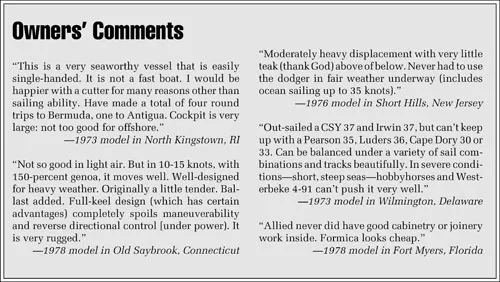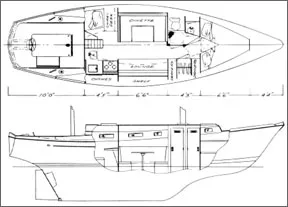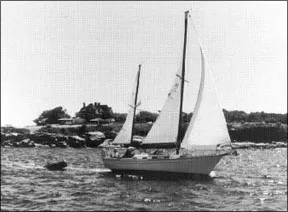The Allied Boat Company built its first boat about 1962. It was the Seawind ketch, designed by Thomas Gillmer, a professor of naval architecture at the United States Naval Academy.

Later the Seawind would become the first fiberglass boat to circumnavigate the globe; she was Apogee, sailed by Alan Eddy of Boston.
As the Catskill, New York company grew, the 30′ 6″ Seawind was replaced by the 31′ 7″ Seawind II, And the product line was expanded to include the Greenwich 24. Luders 33, Seabreeze 35 sloop/yawl, Allied 39 and XL2, among others. The Princess 36 was introduced in 1972 along with the center-cockpit Mistress 39, both designed by Arthur Edmunds. Production ceased in 1982. We don’t know how many were built, but see quite a few in the listings of Soundings. Also, many small changes were made during the course of production, and we won’t attempt to report all of those that we know.
Allied was plagued with financial difficulties throughout much of its life, changing ownership several times, and finally succumbing in 1982. With the exception of one Britton Chance racer, all of Allied’s boats were cruisers that, according to our 1982 review of the Seawind II, suffered from “bland expanses of fiberglass, and mediocre woodwork.” On the plus side, they were solidly built.
Like its big sister, the Princess has a shoal draft, full keel, drawing just 4′ 6″. Clearly, this boat is not going to point as high as a good fin keel design, but for cruising, especially in the shallow waters of the Chesapeake, Florida and the Bahamas, it’ll be ideal. Plus, with the rudder hung off the trailing edge of the keel, the boat shouldn’t suffer too much damage in the event of a grounding.
Compared to some more contemporary designs of similar size and intent, the Princess has a middle-of the- road beam of 11′ 0″. The Pearson 365, for instance, measures 11′ 5-1/2″.
The waterline is close to the 28-foot minimum that author and circumnavigator George Day considers desirable for passagemaking; heeled, it should lengthen nicely as the ends submerse.
When you first see this boat, either in the water or on paper, the two things that immediately strike you are the sheer and bow. Edmunds put the low point of the sheer at the right place, about two-thirds of the distance aft from the bow. But the bow seems awfully high. In fact, when you walk forward along the sidedecks, you have the definite sensation of walk- ing uphill. Too much, we think, though the look certainly sets the Princess apart from boats with flatter sheers (again, the Pearson 365 comes to mind). Perhaps because of the high bow, Edmunds drew a sort of mini-clipper curve that in the drawing can be seen as an almost S-shape. We like clipper bows on wooden boats, but seldom on fiberglass boats, especially without trailboards, the absence of which makes the boat look like a skinhead without even a ring in its nose to add interest. The high freeboard forward doesn’t help windward sailing ability, and may increase the tendency to sail at anchor. On the plus side, the foredeck is likely to stay a bit drier in a seaway. In fact, owners report the boat is unusually dry.

The coachroof or cabin top has a good deal of camber, which also is distinctive.
The cockpit is large at 10′ long and 6′ wide. There is a bridge deck to minimize the size of the companionway (protected by a storm hood) and make it that much harder for water to get below. An added benefit of bridgedecks, often overlooked, is the amount of interior space opened up for the galley, electrical system, headroom en route to the quarter berths, etc.
An unusual feature of the Princess is its Edson worm gear (or chain-driven pull-pull, or rack and pinion, depending on model) steering, seldom seen on production fiberglass boats.
The forward-facing wheel takes some getting used to, but it affords three convenient seating positions, to port, starboard and aft. And it doesn’t take up as much cockpit space as a pedestal steerer. There is the mizzenmast to reckon with, but it’s at the forward end of the cockpit, where it makes a convenient handhold for crew coming up from below. The seats are long enough for a tall person to sleep on, an important consideration for cruising.
Though there is considerable volume to this cockpit (you don’t worry about how much water one will hold until you’ve been pooped), the bridge deck and aft seating/steerer housing go a ways toward keeping it safe.
All this said, the Princess has an exceptionally comfortable cockpit that is easy to move about, albeit at some expense of safety.
Construction
Allied always enjoyed a reputation for building strong hulls and decks. No hull cores were employed, though balsa was used in the Princess’ deck, as is customary, and to our minds preferable to plywood.
One wouldn’t expect any exotic fibers in a boat built in the mid-1970s, and there aren’t any in the Princess, just 24-ounce woven roving and mat, plus a final layer of cloth, all laid up by hand. Hull thickness increases at the turn of the bilge and more at the keel. The internal ballast (meaning the keel cavity is part of the hull mold) is lead, glassed over with two layers of mat and woven roving so that if the keel is punctured during grounding, no water will presumably enter the cabin.
An early brochure says voids between the lead and hull are filled, but it doesn’t say with what material. (We discovered, to our chagrin, that the voids in our 1967 Pearson Vanguard were partially filled with sheets of balsa core, which absorbed water like a sponge.)
Bulkheads are bonded or tabbed to the hull, which is the proper way to build a fiberglass boat. Many boats, because of inner liners or pans, do not have the bulkheads bonded on all sides to the hull and deck. (Because of the Princess’s one-piece overhead liner, we couldn’t tell whether the bulkheads were tabbed to the deck.) This creates a strong basic structure, but tabbing (strips of fiberglass mat) does occasionally break away from the bulkhead due to continual working of the hull or because the builder didn’t first remove the veneer from the plywood bulkhead to achieve a stronger bond. Check it. If the fiberglass tabbing is exposed, repairs to it aren’t all that difficult.

The hull and deck (which includes the toe rail molding) are caulked by an unspecified “bonding” material, then through-bolted on 5″ centers and glassed over. The flanges are on the outside, and so to protect them from collision with, say, pilings, the joint is covered with an aluminum extrusion.
We’re not all that fond of outward-turning flanges, and protecting them is, indeed, important. We think the aluminum does a good job of that, but if it was ever damaged, replacing it could be a major problem.
The rudder stock is 1-1/2″ bronze riding on a 32- lb. bronze heel casting.
One of the things we like best about the Princess is its wooden interior—no fiberglass cabin sole, bunk foundations, etc. Teak, naturally, is the wood used for the cabin sole and trim. The bulkheads are covered with a simulated wood veneer that some owners may want to paint to relieve any phobias about cave dwelling. Just remember that for paint to bond to Formica and other laminates, the surface must be well sanded; it isn’t easy and the paint may still peel when nicked. It’s a one-way street, because you can’t strip the paint and go back to sanded laminate. Other alternatives are to use a tie-coat as a primer (our experience is that they can be difficult to apply smoothly), or to glue on a new thin veneer of real wood.
For ventilation, there are two Dorade vents and an opening hatch forward; opening portlights were optional. Retrofitting a small deck hatch over the saloon table would do a lot to improve air flow in the main cabin.
Interior Plan
The almost style-less line drawing of the interior shows a fairly standard layout, with just a few wrinkles. Each V-berth forward measures 6′ 7″ x 2′ 8″. There is a sink separated by a half-bulkhead from the toilet; a shower and sump were optional. A 1972 brochure shows the sink behind the forward door to the head, while a 1973 brochure shows it outside the head entirely. This move did add space to the forward cabin, but we wonder how the person sleeping would like it when some guest washes his hands after a nocturnal urination?
Elsewhere, there is a U-shaped dinette measuring 6′ 6″ x 2′ 0″ (later models had settees with drop-leaf table), with stowage compartments behind the backrest; hanging locker and bureau drawers; Lshaped galley; and combination port quarterberth/navigation table. Like the other berths, it is of adequate length at 6′ 6″. On a few boats we’ve seen, this area has been enclosed with bulkheads to make a very small aft quarter cabin. Fortunately, a large cutout in the forward bulkhead allows for some ventilation to this otherwise tight area.
Other details worth noting: Headroom is a generous 6′ 4″. Freshwater capacity is variously reported at 80 and 90 gallons in a stainless steel tank under the main cabin sole. Fuel is reported as 40 gallons, first in a black iron tank, later in one of Corten steel, which is preferable. The first boats were equipped with a single 60-amp battery, which is almost laughable today. This was quickly increased to 90 amps, but today’s owner surely will want at least two series 27 105-amp batteries, much more if he has 12-volt refrigeration or an autopilot.
Performance
Owners responding to our Boat Owner’s Questionnaire report that the Princess has just average to below average speed sailing upwind. This is not surprising considering its long, shallow keel and ketch rig. Off-the-wind performance is rated average.

But the seaworthiness ratings give credit to the design, coming in at above average to excellent. Says one owner, “I’ve owned nine boats, and this is the best of all.”
In terms of stability, a number of owners say she is initially tender but settles in nicely, seldom putting the rail under. Walter Schultz, builder of Shannon sailboats, used to deliver Allieds down the Hudson River to Long Island, and says the Princess is the second most tender boat he’s ever sailed (the first is the Seawind II).
The Princess tracks well, and the rig can be balanced nicely if the right combination of sails is set. Owners with steering vanes say they do a good job on this boat, no doubt due to the lateral surface area of the keel and balanced rig (remember that when sailing upwind, the mizzen may cause weather helm and so is often struck).
“Have left helm for half-hour with 20-30 knots on beam in 6-8-foot seas!” croons one owner of a 1976 model.
This is in part possible because of the worm gear steering, which is non-reversing (and so gives no feedback to the helmsman). Worm gear steering is practically bombproof and easy to steer upwind. Off the wind, however, we have found the three turns lock to lock too many to comfortably handle quartering seas.
The Princess is powered by a 25-hp. Westerbeke 4-91 diesel with 2:1 reduction gear, a good engine but, if original, probably growing tired. It turns a 17″ by 11″ three-blade propeller, which gives it good thrust but lots of drag under sail. There are the usual complaints of handling in reverse.
“Terrible,” says one owner, adding, as did several others, that the high bow adds to docking problems in a cross wind. A number of owners complained that the engine is too small for the boat, citing difficulties powering into head seas. If repowering, consider an engine of about 40 hp.
Conclusion
Despite a few drawbacks (unusually springy sheer, draft too shoal for a 36-footer, large cockpit, and tenderness) we like this boat, and think it is an exceptional value for the budget-minded cruiser. Though one owner said he doesn’t recommend it for blue-water passagemaking (“too tender”), we have heard from others who have traveled far and wide on the Princess, including one circumnavigation.
It is not a fast boat, but comfortable, as a cruising boat should be. One would think that the diesel and big prop would give it the power to handle the head seas so often encountered in coastal cruising, but a number of owners say it doesn’t (this may be partly due to the high bow and hull shape). The shallow draft, a potential liability when sailing offshore, makes it ideal for cruising the Intracoastal Waterway, the Chesapeake Bay, Florida Bay and the Bahamas.
The interior has three good sea berths, which is all you can ask for in most any boat. A strap will hold the cook securely to the galley, and the chart table, though modest, will suffice for navigation purposes. At anchor, the large V-berth with overhead hatch will be the bunk of choice due to superior ventilation.
The introductory price of the Princess was $25,995, ketch or sloop (we’ve never seen a sloop). Today, the BUC Research Used Boat Price Guide reports that 1972 model as being worth between $37,600 and $41,800. Later models (built by Wright/Allied after a change in ownership) may be worth, BUC reports, as much as $59,300 to $65,900. We’ve tracked 1970’s Princess 36 prices pretty closely and believe you can buy one in decent shape somewhere in the mid-40s, a bit more for later models in great condition.
We doubt we’d pay a $10,000 premium for a 1980’s model unless (a) we had a lot of easy cash to spend, and (b) the boat had been repowered with a newer diesel, and equipped with other still-functional goodies we wanted, such as an autopilot, radar, electronic instruments, etc.
The beauty of the Princess, as we see it, is a robustly character ketch at an affordable price. Compared to the Pearson 365, it’s better built (we still don’t like the fiberglass inner liner and screwed together hull-deck joint of the P365, though there is much else to appreciate, e.g., the bathtub!) and less expensive.

































GOOD article this is the info i needed to help choose a boat for me. the fact of the matter is having a more stbale boat is moe inportant to me then record speed. in my opinion this boat is an excellent starter boat.